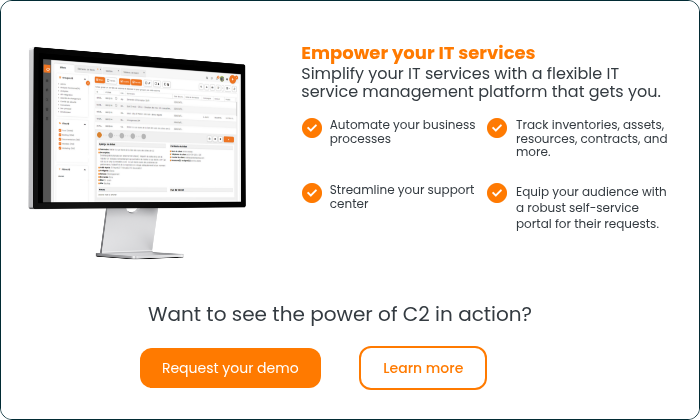
You’re implementing a new IT Service Management tool. You mapped out everything: setup, installation and testing—your bases are covered. You also trained all users, letting them know exactly how to use the new solution.
But despite your planning, rumors emerge that some employees don’t want to work on the new system. Some are even afraid of losing their jobs or not being proficient with the latest software solutions. Unfortunately, this sequence of events is quite common.
It’s important to put extra effort into preparing the human side of the organization when carrying out the change management process of implementing a new ITSM platform. The IT side is essential but remember that the latest technology supports the people. They are the priority.
Implementing an ITSM tool requires managing people and technology
Everyone will respond differently to change, depending on their place in the organization, their job duties and their psychology. Study results show that less than one-third of all organizational transformations are successful in improving and sustaining improved performance over time.
Several emotional causes lurk behind user resistance to change that we need to navigate, including insecurity, fear and apprehension. With that concern in mind, we wanted to share six tips for being more people-centric when deploying a new ITSM implementation.
Get top-down buy-in: engage your executives
The leadership team’s commitment to the project is considered the most significant success condition. Get your executive leadership team to communicate this change to the relevant departments. Ensure each member communicates their endorsement of your ITSM implementation to employees in their vertical. Employees are more likely to feel the change is significant when senior management leadership is involved and on board.
Mobilize managers
In addition to senior leadership, change management requires management support. IT managers are usually the bridge between senior management and employees. They have a good idea of the upcoming change and should endorse it. Afterward, answering employee questions and demonstrating a positive attitude will be easier.
Communicate details
Senior leadership must detail their strategic vision for the importance of your ITSM project. The organization must remain transparent to a certain extent so that confidence remains undivided. Everyone needs to understand the scope in detail—the why, the what, the how, and the impact this change can have.
The best communication method in this kind of change is an in-person meeting, not mass emailing. The organization should also prioritize meetings between management and employees so that they can respond directly and transparently to their employees' uncertainties.
Get bottom-up buy-in: identify the champions
A champion is a credible, experienced or skilled operational employee who communicates important information to colleagues. They’re someone colleagues look up to.
For an ITSM software implementation, a champion could be a senior coordinator, a system administrator or a help desk power user. Employees could better accept the message that this is a positive change if it comes from a colleague rather than an external trainer or an executive. In addition, the more positive employees engaged in a change process, the greater the chances that these people can influence more resistant employees.
Positively engage resistant employees
As your implementation rolls out, identify employees who resist the most and try to involve them as much as possible, either at the early stage of the software configuration, in the decision-making process or in testing and piloting the application. Resistance often stems from a lack of information and perspective.
For example, an employee might wonder, “If we implement a new solution that can automate some of our current processes, will I still have a job afterward?” To answer this question, you can involve your employees in the first steps of the process and configuration, and they will perhaps realize that yes, they will always have a job. In fact, they’ll have a job with less busy work and more efficient operations.
Updates stakeholders throughout the project
When you’re implementing an ITSM tool, it’s important to communicate up front to all stakeholders the proposed project timeline. Set expectations for how stakeholders will need to be involved and explain what any potential disruptions to their existing workflows might look like.
Communication shouldn’t end there. You’ll need to keep everyone updated as the project unfolds. Keep relevant stakeholders up to date if you need to adjust project milestones and timelines or make any other change that will impact day-to-day operations for stakeholders.
Also, keep them informed if their expectations for the new ITSM solution need to change. Again, that is more about a strategic perspective than day-to-day operations, but maintaining support for your project is just as important.
Implementing an ITSM tool the right way takes patience, but it’s worth it
Resistance to change is a common reaction in people across job types and social statuses. It’s human nature we should expect to deal with during major change projects. It takes some work to overcome, but you will see many benefits by thinking through specific resistance scenarios and options to resolve them. If you don’t schedule the time to manage these resistant employees, you risk them negatively influencing other staff members and end up with even more ingrained resistance.
But if you invest the time in developing a good change plan that accounts for both the technology and the people you want to change, you’ll set up your project for success. Implementing your new ITSM tool will go more smoothly, your employees will be more likely to adopt those tools (making their lives easier), and you’ll more easily hit your KPIs. Your project becomes a win-win.






